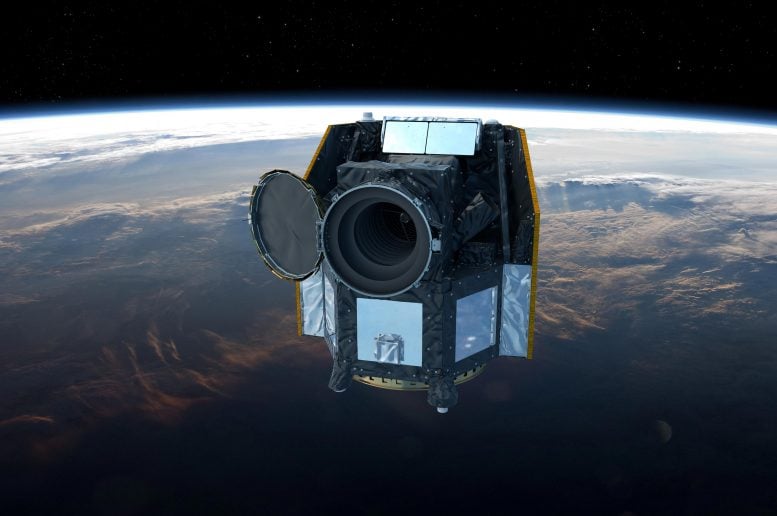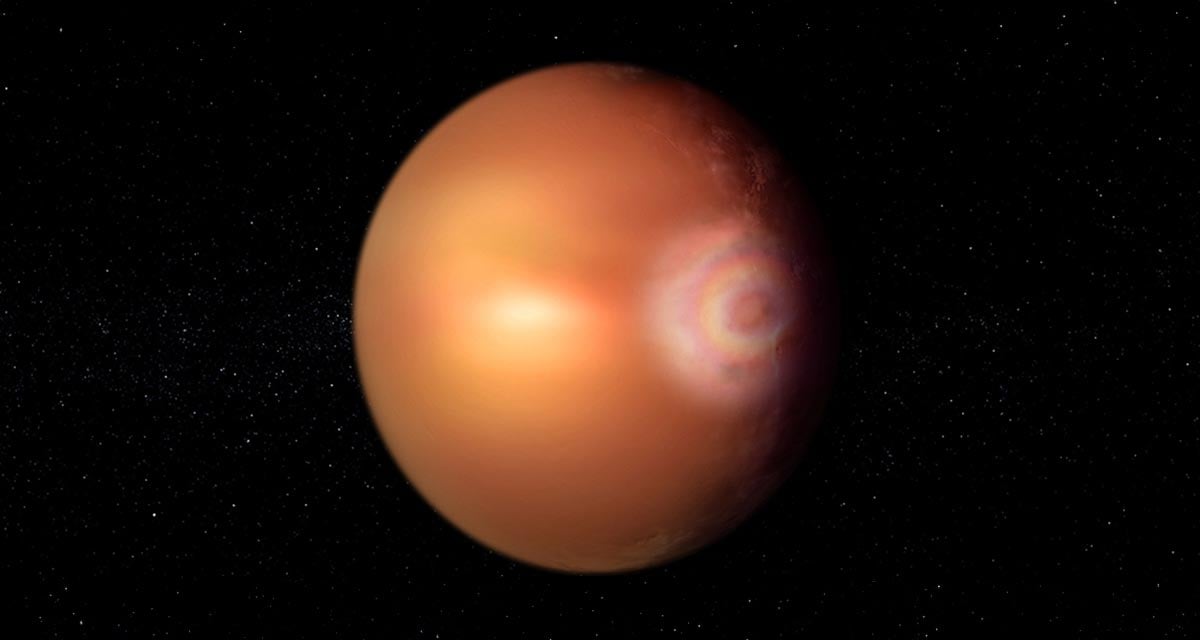Each glow is unique, depending on the composition of the planet’s atmosphere and the colors of light from the star that illuminates it. WASP-76 (the “sun” of WASP-76b) is a yellow-white main sequence star like our sun, but different stars produce glories with different colors and patterns. Photo credit: ESA, work carried out by ATG on behalf of ESA. CC BY-SA 3.0 IGO, edited
New observations from the space telescope suggest the existence of a “glory” in WASP-76b’s atmosphere, a luminous phenomenon like a rainbow.
The CHEOPS space telescope, whose scientific operations center is based at the University of Geneva (UNIGE), provides new information about the mysterious exoplanet WASP-76b. This ultra-hot giant is characterized by an asymmetry between the amount of light observed at its eastern terminus – the fictitious line that separates its night side from its day side – and the amount of light observed at its western terminus. This peculiarity is believed to be due to a “glory,” a luminous phenomenon similar to a rainbow that occurs when light from the star – the “sun” around which the exoplanet orbits – is reflected from clouds emerging from a planet completely uniform form consists of substance. If this hypothesis is confirmed, it would be the first discovery of this phenomenon outside our solar system. This work was carried out in collaboration with the European Space Agency (ESA) and the University of Bern (UNIBE), published in Astronomy and astrophysics.
WASP-76b is an ultra-hot giant planet. Because it orbits its host star twelve times closer than Mercury orbits our sun, it receives more than 4,000 times the solar radiation on Earth. “The exoplanet is ‘inflated’ by the intense radiation from its star. So although it is 10% less massive than our cousin Jupiter“It is almost twice as big,” explains Monika Lendl, assistant professor in the Department of Astronomy at the UNIGE Faculty of Natural Sciences and co-author of the study.
Elements that would form rocks on Earth
melt and evaporate, creating iron clouds
the molten iron rain drips.
Since its discovery in 2013, WASP-76b has been the subject of intensive study by astronomers. A strangely hellish picture emerged. One side of the planet always faces its star and reaches temperatures of 2,400 degrees Celsius. Elements that would form rocks on Earth melt and vaporize here before condensing on the slightly cooler night side, forming iron clouds from which molten iron rain drips.
The decisive contribution of CHEOPS
One of the most disturbing observations for astronomers is the asymmetry between the planet’s two terminators. The terminator is the imaginary line that separates the day and night sides of a planet. In the case of WASP-76b, observations show an increase in the amount of light from the terminator in the east of the planet compared to that in the west.
To solve this mystery, astronomers used no fewer than 23 observations with the CHEOPS space telescope, spread over three years. The ESA satellite, controlled by Switzerland and having its scientific operations center in the UNIGE Astronomy Department, observed numerous secondary eclipses of the planet (as it passes behind its star) and several phase curves (continuous observation during a complete orbit of the planet) . Planet).

Artist’s impression of CHEOPS. Photo credit: © ESA / ATG medialab
By combining this new data with that of other telescopes (TESSHubble and Spitzer), astronomers were able to put forward a surprising hypothesis to explain the excessive flux of light on the planet’s eastern side: “This unexpected glow could be caused by a strong, localized and anisotropic reflection – that is, one that depends on the direction – what we call fame,” explains Olivier Demangeon, researcher at the Instituto de Astrofísica e Ciências do Espaço in Portugal and lead author of the study.
A first outside our solar system
Glories are widespread phenomena on Earth. They were also watched Venus. The rainbow-like effect occurs when light reflects off clouds made up of perfectly uniform droplets. In the case of Earth, the droplets are made of water, but the nature of these droplets on WASP-76b remains mysterious. It could be iron, as it has already been detected in the planet’s extremely hot atmosphere. The discovery of this phenomenon on WASP-76b is the first of its kind outside our solar system.
Recognize such tiny phenomena
at such a great distance scientists will be able to do it
to identify others who are equally important.
“The reason why such splendor has never been observed outside our solar system is because this phenomenon requires very specific conditions. First, the atmospheric particles must be almost perfectly spherical, completely uniform, and sufficiently stable to be observed over long periods of time. These droplets must be illuminated directly by the planet’s host star and the observer – in this case CHEOPS – must be in the correct position,” explains Olivier Demangeon.
Results must be confirmed
More data is needed to confirm with certainty that this fascinating excess of light at WASP-76b’s eastern terminator is a showpiece. This confirmation would demonstrate the presence of clouds composed of perfectly spherical droplets that have existed for at least three years or are constantly renewing. For such clouds to persist, the temperature of the atmosphere would also have to be stable over time – a fascinating and detailed look at what could happen on WASP-76b.
Detecting such tiny phenomena from such great distances will allow scientists and engineers to identify other equally crucial phenomena. For example, the reflection of starlight on liquid lakes and oceans – a necessary prerequisite for habitability.
Reference: “Asymmetry in the atmosphere of the ultra-hot Jupiter WASP-76 b” by ODS Demangeon, PE Cubillos, V Singh, TG Wilson, L Carone, A Bekkelien, A Deline, D Ehrenreich, PFL Maxted, B.-O . Demory, T Zingales, Lendl M, Bonfanti A, Sousa SG, Brandeker, Alibert Y, Alonso R, Asquier J, Bárczy T, Barrado D, Barrado Navascues, SCC Barros, W Baumjohann, M Beck, T. Beck, W. Benz , N. Billot, F. Biondi, L. Borsato, Ch. Broeg, M. Buder, A. Collier Cameron, Sz. Csizmadia, MB Davies, M. Deleuil, L. Delrez, A. Erikson, A. Fortier, L .Fossati, M. Fridlund, D. Gandolfi, M. Gillon, M. Güdel, MN Günther, A. Heitzmann, Ch. Helling, S. Hoyer, KG Isaac, LL Kiss, KWF Lam, J. Laskar, A. Lecavelier des Etangs, D. Magrin, M. Mecina, Ch. Mordasini, V. Nascimbeni, G. Olofsson, R. Ottensamer, I. Pagano, E. Palle, G. Peter, G. Piotto, D. Pollacco, D. Queloz , R. Ragazzoni, N. Rando, H. Rauer, I Ribas, M Rieder, S Salmon, NC Santos, G Scandariato, D Segransan, AE Simon, AMS Smith, M Stalport, Gy. M. Szabó, N. Thomas, S. Udry, V. Van Grootel, J. Venturini, E. Villaver and NA Walton, April 5, 2024, Astronomy and astrophysics.
DOI: 10.1051/0004-6361/202348270
